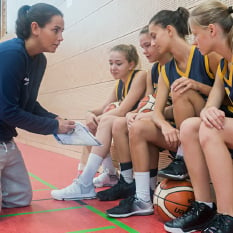Help students develop transferable skills through practical lesson plans from Barclays LifeSkills.
With COVID-19 disrupting education and the labour market, and technological advances increasing the pace of change, today’s young people need to be more versatile than any previous generation.
Core transferable skills can be applied in any industry and almost any job role, and carried between the many jobs that people today are likely to have during their working lives. New jobs will also emerge over the coming years, as technology and consumer requirements change all aspects of the workplace and the jobs landscape.
It’s important that young people recognise and continue developing transferable skills as they join the workforce of today, as these will continue to serve them in future roles which may yet not exist.
1. LEADERSHIP SKILLS lesson plan

Leadership skills are about supporting, encouraging and motivating others in order to achieve a shared goal.
This lesson encourages students to explore the concept of leadership, its different styles and the importance of teamwork and inclusion when being a leader.
By the end of the lesson students will be able to:
- Identify key leadership qualities
- Give a wide variety of examples of leadership and recognise that anyone can be a leader
- Understand the importance of teamwork as part of being a leader
- Understand how to promote inclusivity while practising leadership skills in a classroom or workplace scenario

2. AIMING HIGH lesson plan

Aiming high, also known as proactivity, is the ability to set clear, tangible goals and devise a robust route to achieving them as well as taking the initiative and making things happen, instead of always reacting to what happens around you.
This lesson supports students in recognising the importance of aiming high and how to identify opportunities to be proactive and reach their future goals.
By the end of the lesson students will be able to:
- Identify opportunities to aim high in their everyday lives
- Understand the difference between being proactive and reactive
- Recognise how being proactive can help them aim high and achieve their goals
3. ADAPTABILITY lesson plan
Adaptability is the ability to cope and thrive in changing
conditions.
This lesson helps students to understand the concept of adaptability, why how you respond to change is important and how to apply adaptive thinking.
By the end of the lesson students will be able to:
- Understand why adaptability is a core skill for the future world of work
- Identify the traits, skills and characteristics that make someone adaptable
- Understand that adaptability skills can be developed by anyone and be applied in many situations — not just at moments of major change.
4. PROBLEM SOLVING SKILLS lesson plan
Problem solving is the ability to find a solution to a complex situation or challenge.
This lesson equips young people with an adaptable approach to solving problems, large or small. It includes a video and scenarios that encourage development of practical problem solving skills which can be useful for learning, day-to-day life, and when in employment.
By the end of the lesson students will be able to:
- Identify problems of different scales and what is needed to solve them
- Illustrate the use of an adaptable approach to solving problems
- Understand that problem solving is a core transferable skill and identify its usefulness in a work setting
- Work on a problem solving activity in a team
5. COMMUNICATION SKILLS lesson plan
Communication is the receiving, retaining and processing
of information or ideas as well as the oral transmission.
This lesson helps students to explore different types of communication and how to effectively adapt their communication style.
By the end of the lesson students will be able to:
- Identify the essential aspects of good communication, including its contribution to effective teamwork
- Demonstrate essential aspects of listening and presenting and other forms of communication
- Explain potential consequences of poor communication at work
6. CREATIVITY lesson plan
Creativity is the use of imagination and the generation of new ideas.
This lesson encourages students to stretch their creativity to support their learning across the curriculum and create opportunities in the workplace.
By the end of the activity students will be able to:
- Explain and identify how creative skills can be useful at school and work
- Demonstrate ways of working together to reach creative conclusions
- Use different methods of creative thinking to find solutions
7. RESILIENCE lesson plan
Resilience, or staying positive, is about the ability to use tactics and strategies to overcome setbacks and achieve goals.
This lesson helps students to develop the skills needed to overcome setbacks by exploring how they could respond in different situations.
By the end of the lesson students will be able to:
- Explain the importance of staying positive (resilience), including in relation to the workplace
- Understand the importance of learning from experiences, even if they are negative
- Explain different strategies they can use to build resilience and manage personal challenges and setbacks
These insights were brought to you by Future TalentEd magazine.
This piece was first featured in our Autumn/Winter 2020 issue of Future TalentEd magazine for careers leaders, parents and students.